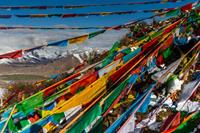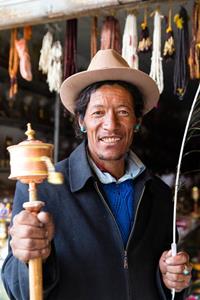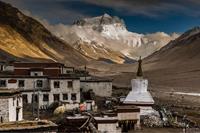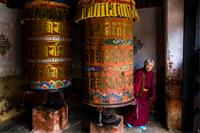There are few corners of the world where Richard I'Anson has not photographed. His work features in over 500 Lonely Planet guidebooks, including five editions of the 'Lonely Planet's Guide to Travel Photography', as well as the large format pictorials, 'Australia: 42 Great Landscape Experiences, Nepal' and 'India: essential encounters'. He is a Master of Photography awarded by the Australian Institute of Professional Photography (AIPP) and represents Canon Australia as a Canon Master Photographer.
Richard has built an enviable career on his twin passions: travel and photography. Over the past 35 years, Richard has travelled the world, amassing a substantial and compelling collection of images of people and places – in more than 90 countries on all seven continents. And when he’s not on the road, Richard lives in Sydney, Australia and runs workshops teaching all aspects of travel photography for individuals and small groups.
Over the last two decades Richard has made a significant contribution to World Expeditions' brochures and guides a number of our specialist photography trips. If you haven't yet seen the National Geographic Channel television series Tales by Light, now screening on Netflix, add the series to your watch list. Richard was one of five adventurous photographers selected for the award-winning documentary, where he provides insights into his craft and the art of telling powerful stories from images.
But before you click off to Netflix, have a read of the amazing destinations Richard has captured over the years and adopt some of his helpful photography tips the next time you're out on your adventure. He shares ways to improve your photo taking skills, his must-carry gear items and how he started in the business.
Being a travel photographer is something many people aspire to be, however the industry is very hard to get into. How did you start your career as a travel photographer and what advice would you give someone wanting to start a career in travel photography?
My first foray into travel photography was in 1986 when I headed overseas for seven months. I soon realised that not only was there a wonderful connection between travel and photography but that I loved to travel just as much as I loved photography. I now consider that trip, which took me through a dozen countries including China, India, Nepal, Morocco and Turkey, as my apprenticeship.

Back at home I studied the results and realised I still had a lot to learn. Two years of intense picture taking around Australia, lots of reading on photography and studying the work of other photographers followed, as I prepared for my next big trip, two years in Asia. This second journey was clearly focused on building a comprehensive collection of photographs from across the region. When I returned to Australia I had enough material to confidently approach picture editors, publishers and travel companies (including World Expeditions) and announce myself as a travel photographer.
Travel photography is arguably the most competitive of photographic genres thanks to the fact that the subject matter is the preferred subject matter of nearly everyone with a camera, especially when they are on holiday. Aspiring photographers need to understand that travelling to take photographs with the aim of making a living is very different from taking photos while travelling.
Professional travel photography is about commitment to the image.
Nothing gets higher priority than being in the right place, at the right time, all of the time which will give you the best chance of building a large collection of images with broad geographic and subject coverage. You also have to be prepared and able to invest time and money in travel to build a substantial collection of high quality images to license as stock and to prove to potential clients that you can do the job.

You’ve won some impressive awards over the years, what does it mean to you to be recognised as one of the world’s leading travel photographers?
It is of course gratifying to receive some recognition, particularly from industry peers, through the various awards. I’ve been in the business now for over 30 years and it’s good to know that people still relate, respond to and enjoy my photography whether it’s through the use of the images in publications or by buying my books and prints or joining a photography trip. Ultimately, I guess it means I can keep doing what I love for a bit longer.
You’ve said that you travel between 90-120 days a year. How do you manage to balance your work as a photographer with spending time actually experiencing the locations you visit?
For me there is no distinction. I have always travelled with photography as the main purpose. I actually think I experience and see way more than the average traveller because I am looking for more than the obvious sights, I often spend longer in places and often revisit places at different times of day.
Some of your most portfolio shots include portraits of people. When you are approaching subjects to shoot, how do you go about it? Do you chat and explain what you’re doing? Or shoot first, ask questions later?
Yes, I do shoot a lot of people pictures, both portraits and environmental portraits. Either way, for really good people pictures, you’ve got to be prepared to get close to your subjects. Except for crowd shots, standing at a distance with a long lens will rarely result in pleasing images, as you generally won’t be able to fill the frame with your subject, and these kinds of shots usually look as though you’ve tried to sneak them, which you have.
Because I’m usually working at close range I always ask permission to take someone’s photo, I see it as common courtesy. Asking permission allows you to use the ideal lens, get close enough to fill the frame, provides the opportunity to take several shots, as well as to communicate with your subject if necessary. In order to still capture natural looking shots, I work quickly and have developed techniques that make photographing people easy and minimise the intrusion into my subject’s day.
I plan the shot before I approach my subject. I think about the composition and make sure I’ve got the right lens on the camera.
Should it be portrait or environmental, horizontal or vertical? I also decide on the viewpoint I think will work best. I study the light on the person’s face and check where it’s coming from; this allows me to position myself correctly in the first instance. Once I have permission to take a photo the person will usually follow me with their eyes if I move.
The slightest change of camera angle can make all the difference.
Being organised and efficient means I minimise drawing attention to what I’m doing, which helps my subject remain relaxed and results in more natural-looking photos.
Finally, I really enjoy sharing the photos by showing the results on the camera’s LCD screen. It’s is a great way to say thank you and, assuming I’ve taken a flattering photo, leave the person with a positive memory of their encounter with me.
What percentage of photos from a trip is pre-planned versus spur of the moment photos that you were inspired to take along the way?
I do a lot of pre-trip research into the places and subjects I want to capture so as to ensure I allow enough time at each destination but I also love just wandering and discovering lesser known places, sights and capturing daily life, so it’s probably 50/50.

Do you feel as though being a travel photographer has changed the way you view the world?
No, not really. I’ve always had a very positive view of the world and its people and my travels and photographic experience have only ever reinforced that. I am truly privileged to have seen so much of the best of the world, rather than conflict, death and destruction that others deal with.
My images are a celebration of the diversity of environments, landscapes and cultures that make up our incredible world.
It continues to amaze me how welcoming and willing people are, from the most remote villages to the biggest mega cities, to share their lives briefly with a stranger and his camera.
What is your favourite destination from a traveller's point of view and from a photographer's point of view?
I’ve been lucky enough to make more than 25 trips to Nepal and can confidently say that for a traveller and a photographer, Nepal is pretty hard to beat. The landscape is so utterly grand it takes your breath away. Importantly though, it is alive with people in the villages and on the ancient trade trails, as vital today as they were centuries ago.
The towns are crammed with magnificent Hindu and Buddhist temples, justifiably famous in their own right, but made so much more interesting because they are an integral part of Nepali life, and the focus of daily religious rituals and annual celebrations.
Since my first trip 30 years ago, witnessing Nepal’s vibrant, open culture against a backdrop of spectacular urban and natural environments has been a regular highlight of my travels.
You’ve led trips to China with World Expeditions, what is it about China in Autumn that you find so appealing and what are some key moments or places you capture on your visit?
China is a brilliant destination for photography at any time, but on this trip we’re going to some of the country’s most scenic places when they will be looking at their absolute best thanks to the vibrant colours of the autumn trees. Apart from the remarkable and quintessential Chinese landscapes around the Great Wall, Yellow Mountains and Yangshuo we aimed to capture a wide range of subjects that portray the diversity of landscapes, urban environments, people and cultures that make China such a fascinating destination.
You’ve said that there are five categories you aim to cover at every location; the landscape, people, urban environment, events and wildlife. Do you have a favourite category to photograph and why?
No, I don’t have a favourite. As a travel photographer I photograph just about everything and I think my strength over the years is that I actually do get excited about shooting just about everything. Ultimately, though I most enjoy the transformative power of light, and I work very hard to be in the right place at the right time in order to capture my subjects in the most beautiful and dramatic light. I’ve come to this conclusion because no matter how magnificent the landscape or built environment if the light isn’t right I tend not to shoot, preferring to return at another time.
How would you describe your photographic vision? What kind of feel do you try and create in your photos?
Because I shoot so many different subjects, it’s difficult to define a specific style. My aim is to match the subject with the best light, and then to compose the elements to produce vibrant images that capture the reality of the moment. I aim to take strong individual images, but am always conscious of how the pictures can build on each other to create a comprehensive coverage of a subject, event or destination, so that viewers get a sense of what it might be like to experience it for themselves. Ideally, I’m aiming to add something new to how people perceive a place and the people who live there.
Can you tell us about the gear you use for your travel photography? What is typically in your camera bag while travelling?
I take the same gear on all my trips except for the 200-400mm zoom, which I use mainly for wildlife photography. It’s big and heavy and so it only comes to places where I know I’ll need it. My choice of equipment is aimed at giving me the flexibility I need to capture the wide range of subjects I cover while being easily manageable and accessible so that I can shoot quickly and efficiently. I rarely leave the hotel without both DSLRs - one with the 24-70mm zoom and the other with the 70-200mm zoom. However, the majority of my pictures are taken on the 24-70mm.
This is what I use:
• Two Canon EOS 1Dx MkII DSLR camera bodies
• Canon EF 16-35mm f4 L II USM zoom lens
• Canon EF 24-70mm f2.8 L II USM zoom lens
• Canon EF 70-200 f2.8 L II USM image stabiliser zoom lens
• Canon EF 200-400 f4 zoom with built in 1.4x converter
• Gitzo G1228 carbon-fibre tripod with Induro ball head.

What are 3 tips for taking great travel photos?
• Don’t assume that your eye level or the first place from where you see your subject is the best viewpoint. A few steps left or right, going down on one knee or standing on a step can quickly improve a composition.
• Make sure your photograph has a clear point of interest. This is usually the thing that caught your eye in the first place and should be the element around which your composition is based.
• Know how your camera works so you can take pictures of all sorts of subjects in all kinds of light and conditions and quickly. So many of the best images are of fleeting moments.
Join Richard on a photography adventure
Learn from the best of the best as Richard takes you through some of the most captivating destinations and scratch beneath the surface to glimpse into the hidden corners of regions, such as the Indian Himalaya and more as he takes you on a photographic exploration of these incredible destinations! View his upcoming photography trips - but hurry, spaces fill up fast.